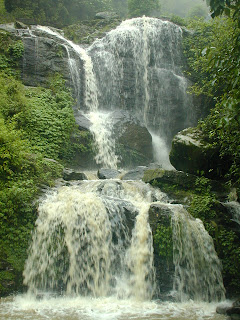Darjeeling (Alt. 2134m), the quintessential hill station is draped over
the ridge with panoramic views of Mt. Kanchenjunga. Its undulating hills
are covered with tea plantations, which has a reputation for producing
best tea, sometimes referred to as the 'champagne of the east.
Darjeeling area belonged to Sikkim until 1780, when it was annexed by invading Gorkhas and later in 1816 British East India gained control over it and returned to Sikkim. In 1835, it was leased to British, who then established tea plantations, built colonial houses and even railway in 1881. Darjeeling provided cool hill retreat and sanatorium for the Bristish officer from their capital in Calcutta. Today, it is a semi autonomous state under West Bengal state called DGHC (Darjeeling Gorkha Hill Council).
The pedestrian town centre is dominated by 'Chowrasta Mall', where you can stroll around and mingle with large Nepali and Tibetan populations mixed with Victorian colonial mansions. Darjeeling has several British-style public schools, which attract students from many parts of India and neighboring countries. Nearby Tiger Hill offers a breathtaking view of the Himalayas which are particularly spectacular at sunrise. There are many things to see and to do in Darjeeling. You can experience a ride on the world famous Toy train from Darjeeling to Ghoom for those who are short on time. Visit Himalayan Mountaineering Institute (HMI), founded in 1954 to encourage mountaineering as an organized sport in India. Tenzing Sherpa, who made the first ascent of Mt. Everest was to become the first field director of this institute. Nearby there is a Zoological Park, the only Zoo in the world to breed Tibetan Wolf in Captivity and the first in South Asian to breed Snow Leopard and Siberian Tiger. The Natural History Museum, contains representative and comprehensive collection of the fauna of the region. The butterfly and beetle section merit a special mention. There are several parks and gardens of which Lloyd's Botanical Garden is the quite known. The other place of interest is the Tibetan Self Help Center, a rehabilitation centre for the Tibetan refugees in the Darjeeling, established in 1959. Center provides shelter, school, health care to about 800 Tibetans. The production of Tibetan handicraft is the centre's main activity. There are several Buddhist temples and monasteries of which the old Ghoom monastery and the new Drukchen monastery are probably the most interesting ones.
Darjeeling area belonged to Sikkim until 1780, when it was annexed by invading Gorkhas and later in 1816 British East India gained control over it and returned to Sikkim. In 1835, it was leased to British, who then established tea plantations, built colonial houses and even railway in 1881. Darjeeling provided cool hill retreat and sanatorium for the Bristish officer from their capital in Calcutta. Today, it is a semi autonomous state under West Bengal state called DGHC (Darjeeling Gorkha Hill Council).
The pedestrian town centre is dominated by 'Chowrasta Mall', where you can stroll around and mingle with large Nepali and Tibetan populations mixed with Victorian colonial mansions. Darjeeling has several British-style public schools, which attract students from many parts of India and neighboring countries. Nearby Tiger Hill offers a breathtaking view of the Himalayas which are particularly spectacular at sunrise. There are many things to see and to do in Darjeeling. You can experience a ride on the world famous Toy train from Darjeeling to Ghoom for those who are short on time. Visit Himalayan Mountaineering Institute (HMI), founded in 1954 to encourage mountaineering as an organized sport in India. Tenzing Sherpa, who made the first ascent of Mt. Everest was to become the first field director of this institute. Nearby there is a Zoological Park, the only Zoo in the world to breed Tibetan Wolf in Captivity and the first in South Asian to breed Snow Leopard and Siberian Tiger. The Natural History Museum, contains representative and comprehensive collection of the fauna of the region. The butterfly and beetle section merit a special mention. There are several parks and gardens of which Lloyd's Botanical Garden is the quite known. The other place of interest is the Tibetan Self Help Center, a rehabilitation centre for the Tibetan refugees in the Darjeeling, established in 1959. Center provides shelter, school, health care to about 800 Tibetans. The production of Tibetan handicraft is the centre's main activity. There are several Buddhist temples and monasteries of which the old Ghoom monastery and the new Drukchen monastery are probably the most interesting ones.















No comments:
Post a Comment